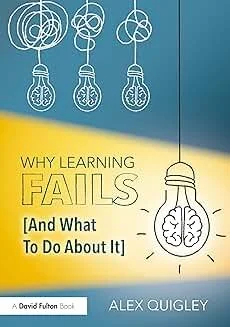Why Learning Fails (And What To Do About It)
Why Learning Fails (And What To Do About It)
by Alex Quigley
A decent book outlining some key problems that pupils face and some general strategies to overcome these difficulties
Recently there has been a proliferation of books that aim to show teachers how to apply insights from cognitive science to their teaching. Although it doesn’t stand out from the crowd, this book covers lots of important issues in an easy-to-read format. The author, Alex Quigley, is Head of Content and Engagement at the educational charity, the Education Endowment Foundation, and is experienced at translating research into practice.
What it’s about
There is a separate chapter on each of eight reasons why pupils may fail to learn:
1. The narrow limits of working memory
2. Patchy prior knowledge
3. The nagging nature of misconceptions
4. A curious case of overconfidence
5. Faulty planning strategies
6. An inability to learn independently
7. Wandering attention and miserly mental effort
8. Falling motivation in the face of failure
Each chapter describes and summarises the ‘challenge’, then offers possible solutions. Alex Quigley uses stories about individual pupil experiences to engage the reader and highlight the difficulties faced by pupils.
The good
If you’re looking for a general introduction to how pupils learn in the classroom and a fairly easy read, this book will suit you well. Issues with working memory are particularly well-described. I work with students who struggle with reading, so I was pleased to see the impact of patchy prior knowledge being emphasised – this issue is fundamental to implementing reading interventions that are designed to ‘plug the gaps’ in students’ learning.
There were some lovely gems hidden in text – my favourite being:
“We can characterise pupils as cognitive misers who seek to survive school with as little hard thinking as they can get away with” (p. 28).
If you work with teenagers, you will recognise this!
The notion of ‘one-shot thinking’ was also helpful – pupils will try the first, easiest method that comes to mind, and if that fails, they may give up. This describes the attitude of many of the struggling readers that I come across very well. My challenge as a teacher is to give pupils the strategies and self-belief that they need to go beyond ‘one-shot thinking’.
The less good
One problem I had with this book was its lack of subtitles! After reading a chapter, I usually wanted to flick back to recap the main points and was just confronted with a wall of text. Although the main structure of the book is very clear, each chapter came across as slightly rambling and, despite final summaries, it wasn’t clear what the most important points were.
I also felt that the book was too general – the blurb describes it as ‘packed with practical advice and examples for teachers across all phases at every stage of their teaching career’, which is a pretty wide audience! The author has clearly tried to present a range of examples from different subjects, but in aiming to provide something for everyone, the book lacked depth.
The takeaway
If you’re a literacy teacher, I’d recommend Quigley’s Closing the Gap series in preference to this book because the information is likely to be more targeted to your needs.

